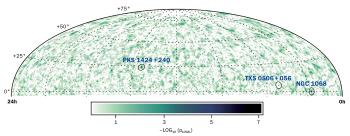
The 28th International Conference on Neutrino Physics and Astrophysics took place in Heidelberg, Germany, on 4–9 June. It was organised by the Max Planck Institute for Nuclear Physics and the Karlsruhe Institute of Technology. With 814 registrations, 400 posters and the presence of Nobel laureates, Art McDonald and Takaaki Kajita, it was the most attended of the series to date – showcasing many new results.
Several experiments presented their results for the first time at Neutrino 2018. T2K in Japan and NOvA in the US updated their results, strengthening their indication of leptonic CP violation and normal-neutrino mass ordering, and improving their precision in measuring the atmospheric oscillation parameters. Taken together with the Super-Kamiokande results of atmospheric neutrino oscillations, these experiments provide a 2σ indication of leptonic CP violation and a 3σ indication of normal mass ordering. In particular, NOvA presented the first 4σ evidence of ν̅μ– ν̅e transitions compatible with three-neutrino oscillations.
The next-generation long-baseline experiments DUNE and Hyper-Kamiokande in the US and Japan, respectively, were discussed in depth. These experiments have the capability to measure CP violation and mass ordering in the neutrino sector with a sensitivity of more than 5σ, with great potential in other searches like proton decay, supernovae, solar and atmospheric neutrinos, and indirect dark-matter searches.
All the reactor experiments – Daya Bay, Double Chooz and Reno – have improved their results, providing precision measurements of the oscillation parameter θ13 and of the reactor antineutrino spectrum. The Daya Bay experiment, integrating 1958 days of data taking, with more than four million antineutrino events on tape, is capable of measuring the reactor mixing angle and the effective mass splitting with a precision of 3.4% and 2.8%, respectively. The next-generation reactor experiment JUNO, aiming at taking data in 2021, was also presented.
The third day of the conference focused on neutrinoless double-beta decay (NDBD) experiments and neutrino telescopes. EXO, KamLAND-Zen, GERDA, Majorana Demonstrator, CUORE and SNO+ presented their latest NDBD search results, which probe whether neutrinos are Majorana particles, and their plans for the short-term future. The new GERDA results pushed their NDBD lifetime limit based on germanium detectors to 0.9 × 1026 years (90% CL), which represents the best real measurement towards a zero-background next-generation NDBD experiment. CUORE also updated its results based on tellurium to 0.15 × 1026 years.
Neutrino telescopes are of great interest for multi-messenger studies of astrophysical objects at high energies. Both IceCube in Antarctica and ANTARES in the Mediterranean were discussed, together with their follow-up IceCube Gen2 and KM3NeT facilities. IceCube has already collected 7.5 years of data, selecting 103 events (60 of which have an energy of more than 60 TeV) and a best-fit power law of E–2.87. IceCube does not provide any evidence for neutrino point sources and the measured νe:νμ:ντ neutrino-flavour composition is 0.35:0.45:0.2. A recent development in neutrino physics has been the first observation of coherent elastic neutrino–nucleus scattering as discussed by the COHERENT experiment (CERN Courier October 2017 p8), which opens the possibility of searches for new physics.
A very welcome development at Neutrino 2018 was the presentation of preliminary results from the KATRIN collaboration about the tritium beta-decay end-point spectrum measurement, which allows a direct measurement of neutrino masses. The experiment has just been inaugurated at KIT in Germany and aims to start data taking in early 2019 with a sensitivity of about 0.24 eV after five years. The strategic importance of a laboratory measurement of neutrino masses cannot be overestimated.
A particularly lively session at this year’s event was the one devoted to sterile-neutrino searches. Five short-baseline nuclear reactor experiments (DANSS, NEOS, STEREO, PROSPECT and SoLid) presented their latest results and plans regarding the so-called reactor antineutrino anomaly. These are experiments aimed at detecting the oscillation effects of sterile neutrinos at reactors free from any assumption about antineutrino fluxes. There was no reported evidence for sterile oscillations, with the exception of the DANSS experiment reporting a 2.8σ effect, which is not in good agreement with previous measurements of this anomaly. These experiments are only at the beginning of data taking and more refined results are expected in the near future, even though it is unlikely that any of them will be able to provide a final sterile-neutrino measurement with a sensitivity much greater than 3σ.
Further discussion was raised by the results reported by MiniBooNE at Fermilab, which reports a 4.8σ excess of electron-like events by combining their neutrino and antineutrino runs. The result is compatible with the 3.8σ excess reported by the LSND experiment about 20 years ago in an experiment taking data in a neutrino beam created by pion decays at rest at Los Alamos. Concerns are raised by the fact that even sterile-neutrino oscillations do not fit the data very well, while backgrounds potentially do (and the MicroBooNE experiment is taking data at Fermilab with the specific purpose of precisely measuring the MiniBooNE backgrounds). Furthermore, as discussed by Michele Maltoni in his talk about the global picture of sterile neutrinos, no sterile neutrino model can, at the same time, accommodate the presumed evidence of νμ–νe oscillations by MiniBooNE and the null results reported by several different experiments (among which is MiniBooNE itself) regarding νμ disappearance at the same Δm2.
The lively sessions at Neutrino 2018, summarised in the final two beautiful talks by Francesco Vissani (theory) and Takaaki Kajita (experiment), reinforce the vitality of this field at this time (see A golden age for neutrinos).








